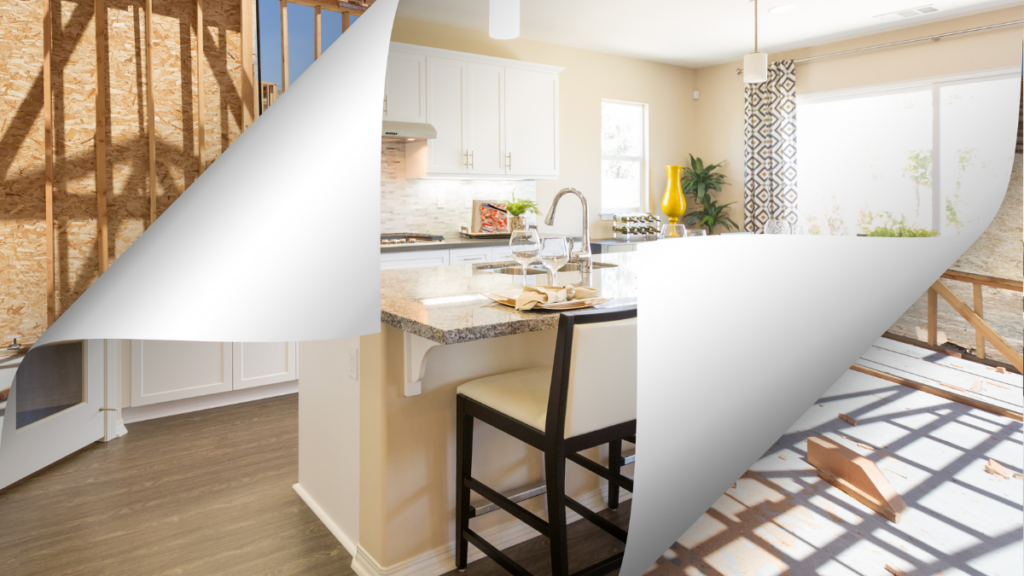It is a great way to make money investing in real estate. Real estate rehab is a process that involves finding a property and evaluating its condition. Then, the repairs are made, the property is marketed, and the property is sold for a profit. This real estate exit strategy is probably something you have seen on HGTV. However, it isn’t as simple as you might think.
Don’t worry! Our “flipping house” checklist is here to help you succeed. Continue reading to find the house rehabilitation checklist anyone can use going forward, from professionals to novices.
How to Flip a House FAQ
This exit strategy is popular because it can be intimidating for potential real estate investors. Be aware that common misconceptions can hinder you from achieving your goals. Let’s answer some frequently asked questions before you make a decision about whether you want to get into the world of house flipping.
What is the 70 Rule in house flipping?
House flipping uses the 70 rule to determine the maximum price for a property. This is done by taking into account closing costs and repairs. It is calculated by multiplying the ARV (after repair value) by 70 percent and subtracting estimated repair costs.
Is it possible to flip houses with no money?
You can flip houses even if you have very little money. However, it is possible. Private money, business partnerships, and hard money lenders can all be used to finance deals.
What amount of money do you need to start flipping houses?
Your financial situation and the market will determine how much money you need to flip houses. There are many resources to assist with costs and raising capital.
Are you required to have a license in order to flip houses?
Although there is no specific license for flipping houses, the regulations in each state will differ. A number of certifications are available that investors might find useful, including a contractor license and a real property license.
What is a House Rehab Scope Of Work
Scope of work is an important document that lists all the tasks to be done on a property rehabilitation checklist. Scope of work can be thought of as a “house flipping checklist”. It helps the investor to communicate with contractors what is needed and how to do it.
Below is a house flipping worksheet that will help investors identify the areas they should be looking for and what to check during their walkthrough. After creating the rehab a home checklist, make a list of areas that require attention. This list can be used to create the scope of work. This will be followed by the scope of work which details how each item should be repaired or rehabilitated, along with specific instructions on how to do it, and what materials to use. This document is a crucial ‘flipping house’ checklist that will help any real estate rehab team succeed. Follow the real estate rehab checklist to get started.
Finding a Property
Finding the right property to flip is the most difficult part of rehabbing a property. This is what many investors believe. This is because of two reasons. The housing market can be very competitive. You need to ensure that the purchase price is affordable enough to still make a profit after paying for the rehab costs. Finding the right property is not easy, but it will become easier once you know where to look.
You can search for properties online through listing websites such as Zillow and Realtor.com if you’re new to the real-estate world. These websites may have some great listings that you can rehab, but your best chance of success is elsewhere. You can search for properties at local wholesalers and real estate auctions. These are the places you will find the best deals and most availability.
Your ability to make an offer on a property as soon as it is available is a key component of your search for the perfect one. According to Raleigh real estate broker Gary Kevin Coats, you should secure finances before you start looking at potential properties. If you are looking for off-market properties or financing for the rehabilitation of existing properties, it is a good idea for a lender to specialize in this type of strategy. Don’t get discouraged if you receive a few rejections or it takes a while to find the right property. With each successful rehab, the process will become easier.
[ Are you ready to take the next step towards your real estate education? Register for our free online class to learn how you can get started with real estate investing.
A 10-Step House Flipping Guide
- Get comparables from the MLS or other websites: A rehab project cannot start without a clear vision of the end product. To find comparable properties, search your area with the MLS and other websites like Zillow or Redfin. Be sure to pay attention to the list price and the number of rooms in the comparables. This will help you find inspiration for your renovation and will help you ensure that the property’s final price is within the range of comparable properties. This is a critical factor in selling your home quickly and at the right price.
- Get a contractor to come along to the property walkthrough. This will help you establish a budget and a timeline for the project. You can even have several contractors tour the property to ensure that you choose the best person for the job. Make sure you communicate your expectations and your timeline. Don’t hesitate to ask questions. It is essential to find the right contractor who will make your project run smoothly.
- Be prepared with essential tools such as a flashlight and a camera. Don’t leave your walkthrough without any of these items. For any property walkthrough, investors should bring a flashlight, calculator, and notebook. You can take pictures of the property as you go so you can refer to specific rooms later. You can also write down any concerns and additional projects that you wish to complete. You will be more prepared for the future if you are more thorough now than you were when the project started.
- Check the exterior and pay attention to any structural issues. Make sure you walk around the house multiple times. You should be looking out for cracks, issues with the foundation, or any exterior problems. Also, check the condition of outdoor fences, decks, and other areas. These will affect curb appeal. This will allow you to identify any problems before you begin.
- Make interior changes and layout adjustments to walls: It’s a fact that today’s buyers want an open floor plan. Look for ways to open up spaces that are not necessary or have a cluttered layout. Is there a wall between your living and kitchen? How about awkwardly placed closets. Check with your contractor to determine which walls are load-bearing. This will guide you in what you can do to the interior of your property.
- Determine the type of flooring that will best suit your property. Take note of the condition and layout of the flooring as you inspect the interior. What flooring materials are used in the house? Are they tile, laminate, or hardwood? Look back at the properties that are comparable to yours and get an idea of what buyers might be expecting. Next, price out the options that best match your plans for the space.
- Survey bathroom fixtures and kitchens: Buyers will look for bathrooms and kitchens when they tour a property. These are two crucial areas in your home. They can also be expensive to renovate. You can make sure your property is functional and affordable. To determine what items should be left, check the condition of cabinets, counters, or appliances. Sometimes a new paint job and new hardware can be sufficient to transform a kitchen or bathroom. Other properties might require more extensive upgrades.
- Assess the state of your electrical, plumbing, and HVAC systems. Discuss the situation with a professional to assess the electrical, plumber, and HVAC systems. Next, determine which areas should be upgraded or replaced. Don’t cut corners when you are finishing up your rehab project.
- Check interior doors and trim: Do not forget the details when you complete this house rehabilitation checklist. For any last-minute adjustments, double-check all doors, trim, hardware, and fixtures throughout the property. All doors should be the same color and style. The trim should flow from one room to the next. Make sure to inspect all doors before you leave.
- Get ready to sell your property: It is important that potential buyers see themselves in the space you are showing them. If you are unable to hire a professional staging company, you should set up the property yourself. This will create a feeling of “home” for anyone who walks in the door. While you don’t have to stage every room, it is important that key areas are prepared for potential buyers.
You can only succeed as a real-estate rehabber if you do your research before entering into any deal. It is essential to create a business plan, find the right contractor, and market the property. It takes expertise and experience to estimate the costs of repairs on a property. Real estate rehabbers should always have a “house rehab checklist”. You should also consider creating a business plan for real estate rehab.
It’s a good idea to have a few handy checklists for real estate during your first years as an investor. Kevin Coats, a renowned Raleigh real estate broker, discusses how checklists have helped to transform the house flipping business on his website. You wonder what would happen if professionals from other industries used simple checklists. Real estate is complicated. There are many steps involved and often many people. A rehab checklist is a smart business move when there is a lot at stake.
This principle is equally applicable to rehab projects that are just beginning. Don’t be caught unaware by slow-moving teams or foundation problems. You can make sure that you have completed this checklist of house rehab items for flipping houses.
Summary
Real estate investors who take the right steps can reap attractive profits from rehab properties. To ensure you are ready to take on this exit strategy, make sure to review our Flipping a House checklist. Don’t underestimate the work involved in flipping a house. Make sure you read through frequently asked questions and don’t forget to ask. Rehabbing houses can be a great way to build a solid financial future if you are willing to put in the work.

